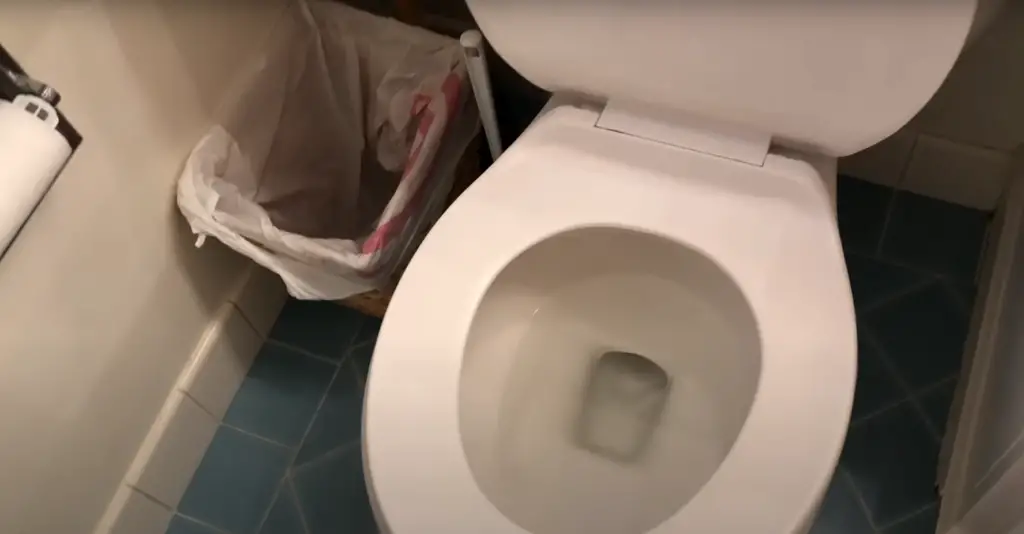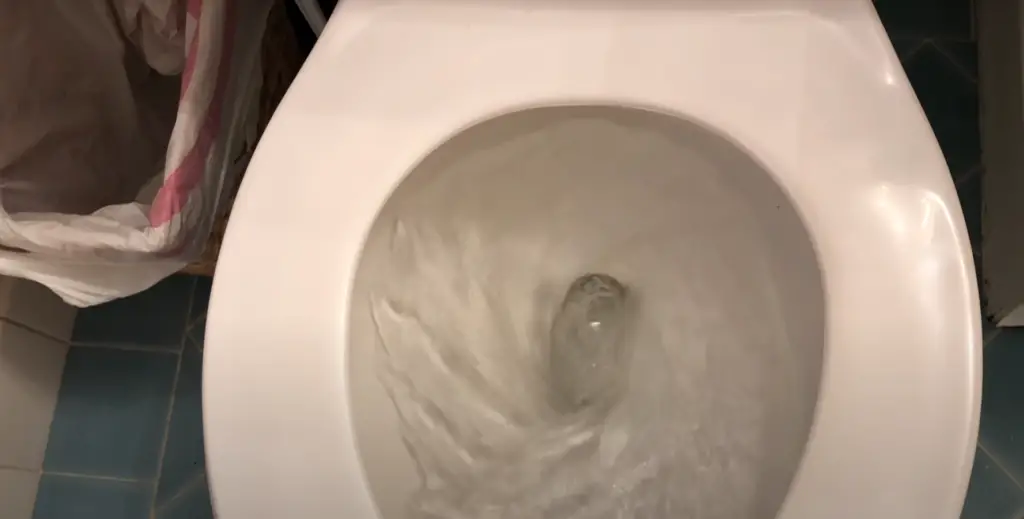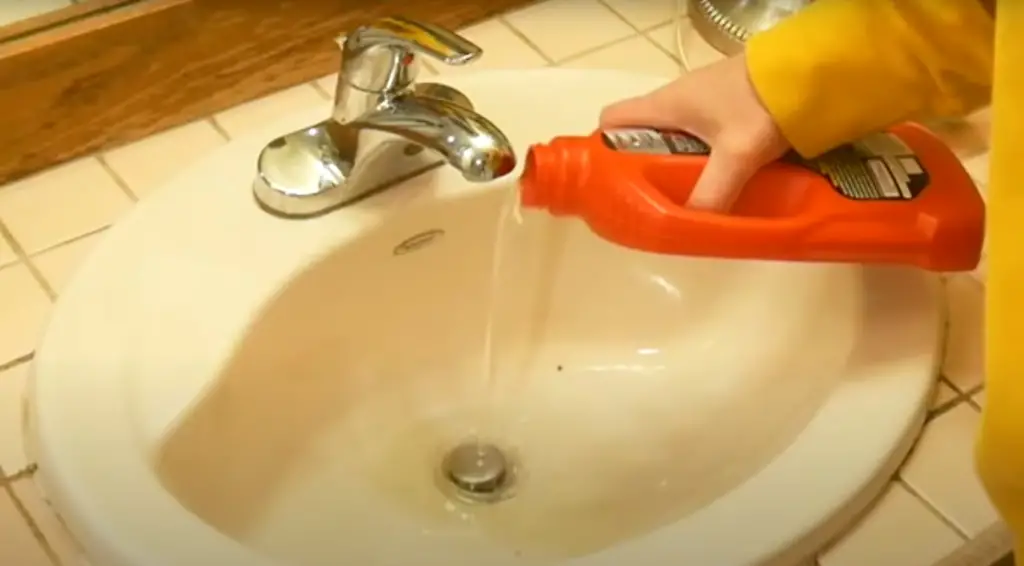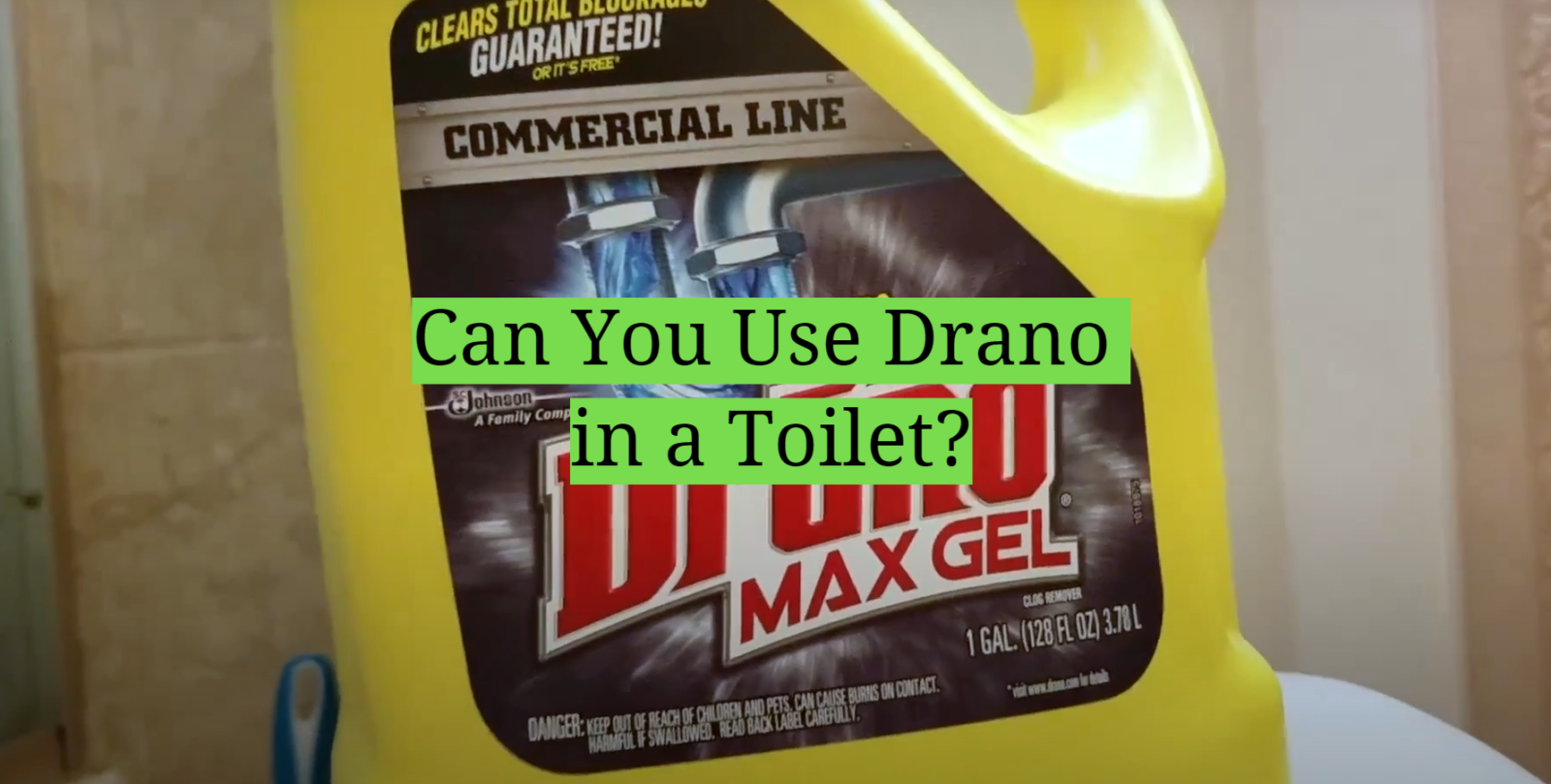Have you ever wondered if it’s safe to use Drano in a toilet? You might have heard that this household chemical is great for unclogging your drains, and while it can indeed be an effective solution, there are some important safety considerations you should take into account before deciding whether or not to use it.
In this blog article, we’ll delve into the advantages and disadvantages of using Drano in a toilet so that you can make an informed decision when faced with a clogged drain. Read on to learn more!
What Is Drano?
It is more powerful than water and can be used to clear clogged drains. However, it is also very dangerous and can hurt people if it is not used correctly.

Advantages of Using Drano in a Toilet
The main advantage of using Drano in your toilet is that it can quickly and easily break up organic matter that might otherwise clog the drain.
It’s also relatively easy to use; all you have to do is pour the recommended amount of Drano directly into the toilet bowl, wait 15 minutes, and flush.
Disadvantages of Using Drano in a Toilet
One of the major drawbacks of using Drano in a toilet is that it can be very dangerous if not used properly. It contains powerful chemicals that are toxic if ingested. Additionally, it can also damage porcelain and other materials used in toilets if not used correctly.
Drano is not a good way to fix a toilet that is stopped up. The chemicals in Drano are only good for breaking up organic matter, but they will not stop the thing that is causing the toilet to be stopped up. This means that the toilet could get stopped up again soon after using Drano.
Why Can’t You Use Drano In A Toilet?
The main reason why you can’t use Drano in a toilet is that it contains powerful, toxic chemicals that can cause harm if they come into contact with your skin or are ingested.
Additionally, the strong chemical reaction between Drano and water can damage porcelain and other materials used in toilets. For these reasons, most experts recommend against using Drano in a toilet. [1]
It Doesn’t Work
Drano doesn’t really work to fix a stopped-up toilet. The chemicals in Drano are only good for breaking up organic matter, but they will not stop the thing that is causing the toilet to be stopped up. This means that the toilet could get stopped up again soon after using Drano.
It Can Damage Your Toilet
Another reason why you shouldn’t use Drano in a toilet is that the strong chemical reaction between Drano and water can damage porcelain and other materials used in toilets. Therefore, it’s important to read the instructions on the package carefully before using a product like Drano in your toilet.

Damages Plumbing
Harmful To Health & Environment
Using Drano in your toilet is not only dangerous to your plumbing, but it can also be hazardous to your health. The chemicals in Drano are toxic and can cause skin irritation if they come into contact with your skin. Additionally, these chemicals can also be harmful to the environment if they come into contact with other bodies of water. [1]
Can You Use Drano in a Toilet?
The short answer is no, you should not use Drano in a toilet. The powerful chemicals contained in Drano can be dangerous if used incorrectly and can also damage materials used in toilets.
Additionally, Drano won’t fix the source of a clogged toilet and could lead to more problems down the line. If your toilet is stopped up, the best thing to do is contact a professional plumber for help.
What to Do if You Put Drano in the Toilet?
If you accidentally put Drano in your toilet, the best thing to do is contact a professional plumber right away. A plumber can safely and effectively remove any clogs caused by the Drano and help make sure that your plumbing remains safe and functional.
Additionally, it’s important to keep an eye out for any signs of damage such as leaks or corrosion, and to get them fixed as soon as possible.

It’s also important to keep in mind that the use of Drano in a toilet is not recommended under any circumstances. If you’re dealing with a clogged toilet, it’s best to contact a professional plumber for help.
Drano Alternatives: How to Unclog Your Toilet
If you’re dealing with a clogged toilet, the best thing to do is contact a professional plumber for help. Doing so will help ensure that your toilet and plumbing remain safe and functioning.
There are a few ways to unclog your toilet without Drano.
- A plunger can help push the clog out of the pipes.
- Baking soda and vinegar can help dissolve any blockages caused by materials like soap scum or hair.
- You can also try using a toilet auger to manually break up and remove a clog from your toilet.
Flange Plunger
It has an extra flap at the bottom that creates a seal against the toilet’s curved drain opening to help push out clogs with more force than an ordinary plunger.

Baking Soda and Vinegar
Baking soda and vinegar can be used to clean your drains. Pour a cup of baking soda into the toilet, followed by a cup of white vinegar. The mixture will start to fizz and bubble up as it works to break up any clogs that may be blocking your pipes.
After 15 minutes, pour a pot of boiling water into the toilet to help flush out any remaining blockages.
Toilet Auger
It has a long handle and metal cable with a sharp, curved end that is designed to break up stubborn clogs in the drain pipe. To use it, simply insert the cable into the toilet and crank the handle to push out any blockages.
Dish Detergent and Hot Water
Another effective way to unclog a toilet is with dish detergent and hot water. Pour one cup of dish detergent into the bowl, followed by two quarts of hot water. The mixture will help break apart clogs caused by materials like soap scum or hair. Allow the mixture to sit in the toilet for 15 minutes before flushing.
Bleach
Bleach can also be used to help unclog a toilet. Simply pour about two cups of bleach into the bowl and let it sit for 15 minutes before flushing. Make sure to use gloves when handling bleach and keep it out of reach from children and pets.
Natural Enzymes
Natural enzyme cleaners are a great way to unclog your toilet without harsh chemicals. Pour the cleaner into the bowl and let it sit for 15 minutes before flushing.

Natural enzyme cleaners are safe, biodegradable, and they won’t damage your plumbing or fixtures.
Does Drano Damage Pipes?
Drano is a powerful chemical that can damage your pipes if you use it incorrectly. You should never use Drano in a toilet and you should always be careful when handling it.
If you have a clogged toilet, it’s best to contact a professional plumber for help. This will help ensure that your toilet and plumbing remain safe and functioning.
When it comes to unclogging a toilet, there are plenty of alternatives to Drano. From plungers and augers to baking soda and vinegar, these methods can help break up stubborn clogs without the use of harsh chemicals.
With a little bit of patience and the right tools, you can easily unclog your toilet and get back to normal in no time. [2]
Causes of Toilet Blockage
Toilet blockages can be caused by different things. They can be caused by things that people flush down the toilet on purpose or by accident. They can also be caused by too much toilet paper, or materials like soap scum and hair.
If you notice your toilet is clogged often, the best thing to do is to contact a professional plumber. This will help prevent further problems in the future.

Clog Prevention
It is important to be careful about what you flush down your toilet so that you don’t cause a clog. You should never flush anything that isn’t meant to go down a toilet, like wet wipes, feminine hygiene products, or cotton swabs.
It is also important to keep an eye on how much toilet paper you’re using and avoid flushing large amounts at once. Finally, regular maintenance like plunging and augering can help keep your drains clear of any clogs.
FAQ
What happens if you use Drano in a toilet?
Using Drano in a toilet can cause damage to your pipes and fixtures. It is best to avoid using Drano in a toilet, and contact a professional plumber if you have a clogged toilet.
Can I use baking soda and vinegar to unclog my toilet?
Yes, baking soda and vinegar can help break up clogs caused by materials like soap scum or hair. Simply pour a cup of baking soda into the toilet, followed by a cup of white vinegar.
Allow the mixture to sit for 15 minutes before pouring a pot of boiling water into the toilet to flush out any remaining blockages.
Can bleach be used to unclog a toilet?
Yes, bleach can be used to help unclog a toilet. Simply pour about two cups of bleach into the bowl and let it sit for 15 minutes before flushing. Make sure to use gloves when handling bleach and keep it out of reach from children and pets.
What can you pour down a toilet to unclog?
There are a few things you can use to unclog your toilet. Baking soda and vinegar, natural enzyme cleaners, or bleach can all help break up clogged material in the pipes.
You should never use Drano in a toilet since it can damage your plumbing and fixtures. If you have a stubborn clog, it is best to contact a professional plumber.
What is the best liquid to unclog a toilet?
The best way to unclog a toilet is to use a natural enzyme cleaner. This kind of cleaner is safe and won’t damage your pipes or fixtures. Pour the cleaner into the bowl and let it sit for 15 minutes before flushing. For tough clogs, you might need help from a professional plumber.
Why is my toilet clogged often?
If your toilet is clogging often, it could be caused by something you’re flushing down the toilet. It can also be caused by too much toilet paper or materials like soap scum and hair.
The best way to prevent further problems is to contact a professional plumber for help. They can identify the source of the clog and help you take the necessary steps to fix it.
Can I use a drain clog remover in the toilet?
No, you should not use a drain clog remover in the toilet. These products contain harsh chemicals that can damage your plumbing and fixtures. It is better to use natural methods like baking soda and vinegar or enzyme cleaners.
Can I use a plunger on the toilet?
You can use a plunger on the toilet. Plungers are a good way to remove clogs that are caused by things like soap scum or hair. Make sure you cover the overflow pipe before using the plunger so that it will work better. If the plunger does not work, you may need to call a professional plumber.
When should I call a plumber for help?
If you’ve tried using natural methods or a plunger and it still doesn’t work, then you should call a professional plumber. A plumber can figure out what the problem is and what to do next. They will also be able to suggest tips on how to prevent clogs in the future so that you don’t have toilet problems again.
Is it okay to use Drano in a toilet?
No, it is not recommended to use Drano in a toilet. This product can damage your pipes and fixtures if used incorrectly or in large amounts. It’s best to contact a professional plumber if you have a clogged toilet. They will be able to help you safely unclog the toilet and suggest preventive measures.
Are there any other methods I can use to unclog my toilet?
There are other ways to try to fix a clogged toilet. One way is to use an auger or plumbers snake to break up clogs caused by things like hair or soap scum.
You can also rent a water jetter from your local hardware store that pumps high pressure water into the pipes to help break up clogs. If your toilet continues to be clogged, it is best to contact a professional plumber for help.
Which is the best way of unclogging a toilet?
The best way to unclog a toilet is using natural methods such as baking soda and vinegar or enzyme cleaners. These are safe and won’t damage your pipes or fixtures. If these do not work, you may need to try more drastic measures like an auger or plumbers snake.
Do I need to call a plumber in order to unclog a toilet?
If your toilet is still clogged after you’ve tried using a plunger or other methods, it’s best to contact a professional plumber for help. The plumber will be able to find the cause of the clog and tell you what to do. They can also help you take steps to prevent toilet problems in the future.
Does unclogging a toilet require any special tools?
Depending on the type of clog you’re dealing with, you might need different tools to unclog your toilet. If it’s caused by something like soap scum or hair, then you can use a plunger or an auger/plumbers snake. If the clog is more severe, then you might need a water jetter or other professional equipment.
Does unclogging a toilet require any special skills?
No, unclogging a toilet is not difficult most of the time. The main skill you need is to be able to identify what type of clog you’re dealing with. Then use the right tool or method for it. If natural methods or a plunger don’t work, then call a professional plumber for help.
Can I use Drano in a toilet if I dilute it?
No, you should never use Drano or any other chemical clog remover in a toilet. Even if you dilute it, the chemicals can still damage your plumbing and fixtures. It is always best to use natural methods to unclog toilets and contact a professional plumber if needed.
When should I replace my toilet?
If your toilet is over ten years old, if it looks like it has been used a lot, or if it keeps getting clogged, then you might need to get a new one. Getting a new toilet can help you save money because you will not need to pay for repairs or water bills. If you are not sure if your toilet needs to be replaced, ask a professional plumber for help.
How can I prevent clogs in my toilet?
There are some things you can do to keep your toilet from getting clogged. Only flush toilet paper down the toilet.
Use a plunger to keep the pipes clear of stuff. Use an enzyme cleaner every month to help break up any build-up. Have a regular maintenance plan with your plumber to keep your plumbing in good condition and ensure that your toilet is working properly.
Are there any other safety tips for unclogging a toilet?
Yes, there are some important safety tips to keep in mind when unclogging a toilet. Always wear protective gloves and eye protection when working with chemicals or tools.
Be sure to follow directions carefully when using these products and avoid contact with skin, eyes, and mouth. If you are unsure of the right way to use a tool or product, ask a professional plumber for help.
Do I need to call a plumber if I have questions about unclogging a toilet?
If you have questions about unclogging your toilet, it is best to contact a professional plumber. They will be able to help you and find the best solution for your situation.
Useful Video: Drano Max Gel Clog Remover Review – Pro Strength
Conclusion
If your toilet is clogged, you may be wondering if Drano is safe to use. The answer is maybe – it depends on the type of clog and what kind of pipes you have. We recommend that you try a plunger first, but if that doesn’t work, then you can try using Drano.
Just be sure to follow the instructions on the bottle carefully and call a plumber if the clog persists.
Additionally, there are other tools you can use to unclog a toilet and prevent clogs in the future. If you have any questions or need help with your plumbing, contact a professional plumber for assistance.
References
- https://www.sunrisespecialty.com/can-you-use-drano-in-a-toilet
- https://weekendbuilds.com/can-you-use-drano-in-a-toilet/










Leave a Reply